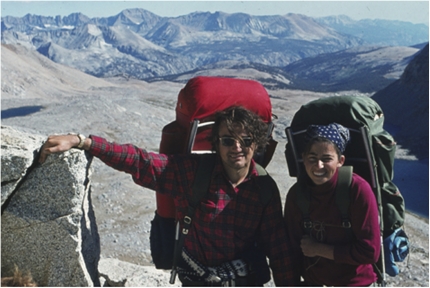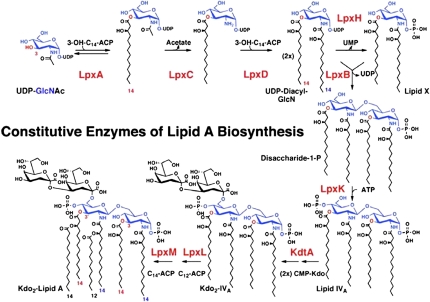When Chris Raetz died of cancer on August 16, 2011, the scientific world lost a polymath, and we lost a cherished friend. Chris was born in East Berlin in 1946. At age 5, his family emigrated to Ohio, where his parents worked for Olin Chemicals. Chris attended Hopkins School in New Haven, Connecticut, and then Yale University, where he majored in chemistry. Bill Wickner, a fellow chemistry major, recalls leaving campus early one weekend, relying on Chris to take notes in their Friday chemistry course. Chris's notes were elegant and clear, except for the derivation of the Grabowski equation. Chris admitted he had not quite understood it, and therefore Bill asked the professor to explain it again in Monday's class. The professor looked puzzled and then, amused, realizing how thoroughly Chris had bamboozled Bill about an imaginary equation. A lifelong friendship was born.
Because they were to enter the same medical school, Bill and Chris decided to room together. In early September, Bill drove a rental van to New Haven and threw in Chris's possessions on top of his own, and they walked his mother's hound while she made lunch. Chris confessed that he had met The One, the girl of his dreams, talking to her on the deck of a boat returning from Europe while she threw up over the rail during a storm. Madeline was entering Brandeis, and, in ensuing years, they went hiking and camping in the White Mountains and later, the Sierras (Fig. 1). Then, they married and had two daughters, Jacqueline, now a physician at the University of Washington, and Elizabeth, an actor.
Fig. 1.
Chris and Madeline in the Sierra Madre Mountains.
Chris's father introduced him to the wonders of chemistry, and his knowledge and feeling for chemistry were profound. At Harvard Medical School, Chris was drawn to Eugene Kennedy's laboratory and the enterprise of purifying the enzymes of lipid metabolism. Postdoctorates Bill Dowhan and Carlos Hirschberg in Kennedy's laboratory joined in morning forays for coffee and greasy doughnuts, and they shared the lifelong passion for membrane biology. After Chris received MD and PhD degrees from Harvard and had an internship year at the Brigham, he began his independent studies as a yellow beret at the National Institutes of Health. Chris then joined the Biochemistry Department in Madison, Wisconsin, and helped hire JoAnne Stubbe. Chris, at age 40, had not learned to drive, preferring to be chauffeured by Madeline. JoAnne finally bet him a pie in the face that he would not or could not bring himself to learn to drive and buy a snazzy sports car, whereupon Chris did both. He delivered the pie to its target with great gusto in front of their biochemistry class.
Chris was possessed of an extraordinary breadth of knowledge from medicine and pharmacology to biochemistry and genetics and on to organic chemistry and structural biology. His work integrated each of these areas in his lifetime pursuit of mechanistic understanding of lipid metabolism. In one seminal, elegant experiment, Chris simply pulse-labeled Escherichia coli with 32P, then extracted lipids, and ran a 2D TLC. After a brief exposure to film, three prominent spots were seen that corresponded to phosphatidylethanolamine, phosphatidylglycerol, and diphosphatidylglycerol. However, successively longer exposures revealed a galaxy of minor spots, which Chris identified through meticulous analytic and synthetic chemistry as the intermediates in lipid A synthesis. Lipid A is the membrane anchor for lipopolysaccharide on the outer surface of Gram-negative bacteria, and it is this lipopolysaccharide that accounts for much of the toxicity of infections. Chris delineated the entire pathway (Fig. 2), obtained mutants, identified the gene for each enzyme in the pathway, and purified and crystallized the proteins, all while seeking ligands with pharmacological potential (1, 2). This work, begun at Madison as he rapidly rose through the ranks to professor, was miraculously nurtured while at Merck as Vice President for Research, where he oversaw the development of Zocor, a statin, and Proscar, a treatment of prostatic hypertrophy. Chris's studies of lipid A biogenesis sprung into full blossom again when he returned to academia at Duke.
Fig. 2.
The Raetz pathway of lipid A biosynthesis (1). [Reproduced with permission of Annual Reviews, Inc. from Ann. Rev. Biochem, Raetz, C. R. H., Reynolds, C. M., Trent, M. S., and Bishop, R. E., 76, 2007; permission conveyed through Copyright Clearance Center, Inc.].
Chris was steadfast in his devotion to pursuit of scientific understanding to a chemical level, in his love for his family, and in his devotion to deep, early friendships. Bill Dowhan recalls when Chris literally saved his life. Chris, Bill, and Carlos Hirschberg were having dinner when food lodged in Bill's throat. Because Chris was an MD, could he assist? Maybe, but being Harvard trained, Bill feared he knew more of the theory than the practice of medicine. Fortunately, Chris rose to the occasion and deftly performed the Heimlich maneuver. Chris and Carlos were, of course, greatly relieved, because the dinner tab could still be split three ways.
Chris received the 1979 Camille and Henry Dreyfus Teacher–Scholar Award, the 2002 American Society for Biochemistry and Molecular Biology Avanti Award in Lipids, the 2006 L. L. M. van Deenen Medal from the University of Utrecht, and the 2006 Frederik B. Bang Award from the International Endotoxin and Innate Immunity Society, and he was elected to the National Academy of Sciences in 2006. Like many of us, the most profound influence on Chris's scientific life was Eugene Kennedy, the pioneer in chemical understanding of lipid biogenesis. We have spent our careers emulating him, but Chris surely came closest.
Chris was an extraordinary scientist, mentor of young scientists, and friend.
His passing at such a young age is a tremendous loss. Chris is survived by his wife Madeline, daughters Jackie and Lizzie, and grandson Leo.
Footnotes
The authors declare no conflict of interest.
See Profile on page 17252 in issue 44 of volume 104.
References
- 1.Raetz CR, Reynolds CM, Trent MS, Bishop RE. Lipid A modification systems in gram-negative bacteria. Annu Rev Biochem. 2007;76:295–329. doi: 10.1146/annurev.biochem.76.010307.145803. [DOI] [PMC free article] [PubMed] [Google Scholar]
- 2.Raetz CR, Whitfield C. Lipopolysaccharide endotoxins. Annu Rev Biochem. 2002;71:635–700. doi: 10.1146/annurev.biochem.71.110601.135414. [DOI] [PMC free article] [PubMed] [Google Scholar]




